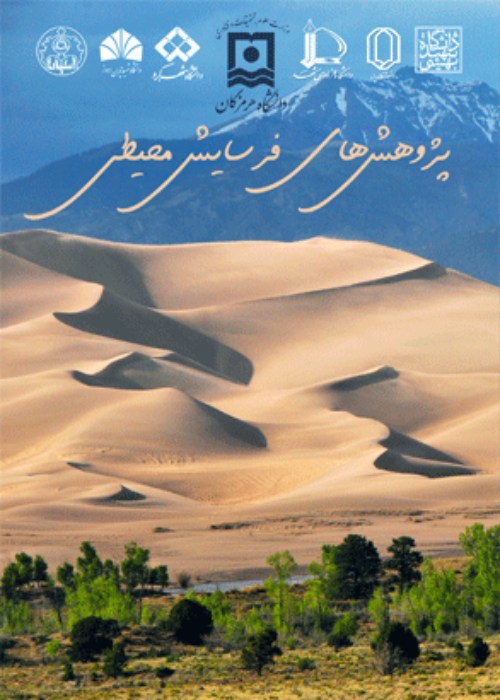Investigating the Effect of Soil and Land Surface Characteristics in the Prediction of Land Subsidence Using Remote Sensing (Case Study: Minab Plain of Hormozgan)
In recent years, Minab plain, one of the most important agricultural plains in the south of the country, has experienced extensive land subsidence. Also, the study of the groundwater level of the Minab plain in a long-term periods showed that since 2001, the drop in the aquifer level has intensified and an average annual drop of 42 cm has been observed. Furthermore, previous geotechnical studies in the region have shown that besides the drop in groundwater level, the presence of swollen and soluble sediments has increased the severity of subsidence in the Minab plain. According to the evidences of the previous studies and damages caused by land subsidence to infrastructure, buildings and agricultural lands, recognizing this phenomenon, identifying areas sensitive to it and investigating the factors affecting its occurrence can play an important and effective role in predicting land subsidence and preventing associated damages. In the current study, unlike other land subsidence studies, which emphasized the drop in groundwater level and the type of geological formations, the characteristics of soil and land surface in the explanation of subsidence phenomenon have been considered.
The study area of Minab plain with an area of 653.6 square kilometers is located between the longitudes of 56° 49' to 57° l5' East and latitudes of 27° 1' to 27° 19' North. First, a time-series analysis of Sentinel-1 radar was performed to identify the land subsidence sites and calculate the displacement rate. After calculating the vertical displacement, for the spatial modeling and the preparation of land subsidence hazard map of Minab plain, data mining methods were employed with soil and land surface features. The investigated time period in the present study covers the years 2015, 2017 and 2019. Spatial variations of 12 variables including soil texture, vegetation, percentages of sand, silt and clay, land surface temperature, soil bulk density, land cover type and soil salinity were gathered and prepared using Google Earth Engine (GEE) and TerrSet software to be used as independent variables of the spatial model. Then, by using Naïve Bayes (NB), Decision Tree (DT) and k-Nearest Neighbor (kNN) data mining models in the RapidMiner software platform, the necessary information was extracted to map the potential land subsidence zones. It is noteworthy that in the constructed models, the land subsidence map for different years (resulting from Sentinel-1 radar image processing) was considered as a dependent variable and the maps accociated with 12 variables mentioned were considered as independent variables. Performance criteria such as classification error, kappa coefficient, absolute error, normalized absolute error, relative error, and root mean squared error were used to evaluate the resulting models with respect to spatial accuracy.
The amount of subsidence for 2015, 2017 and 2019 is computed 3.61, 0.92 and 5.69 cm, respectively. The results obtained by interferometry processes showed that the land subsidence progresses from the central parts of the plain to the edges of the plain and the eastern areas of Minab plain have less amount of land subsidence compared to other areas. Overlap of sinkhole points recorded in the field survey also showed good agreement with the results of radar image analysis. The highest rate of land subsidence, which was equal to 5.69 cm, occurred in 2019. This amount of land subsidence is certainly hazardous for agriculture, the environment and the facilities in the study region.
Among the independent variables, vegetation, heavy soil texture and soil salinity had a more meaningful effect on different land subsidence classes. Also, among the models used for land subsidence risk mapping, the performance of the decision tree method with an accuracy of 63.15, classification error of 36.85, kappa of 29.7, absolute error and relative error of 0.5, normalized absolute error of 0.45 and the sum of the squares error of 0.56 was better than the other two models. Findings of this study showed that soil and land surface characteristics have the ability to express 0.6 of the variance of land subsidence phenomenon in the region and for more accurate modeling, effective data such as changes in groundwater level and the geological material of aquifer can be used. Also, the findings of this study as well as the prepared map of potential land subsidence occurrence in different parts of the study area can play an important role in risk reduction, land use planning and water resources management in the region.
- حق عضویت دریافتی صرف حمایت از نشریات عضو و نگهداری، تکمیل و توسعه مگیران میشود.
- پرداخت حق اشتراک و دانلود مقالات اجازه بازنشر آن در سایر رسانههای چاپی و دیجیتال را به کاربر نمیدهد.



